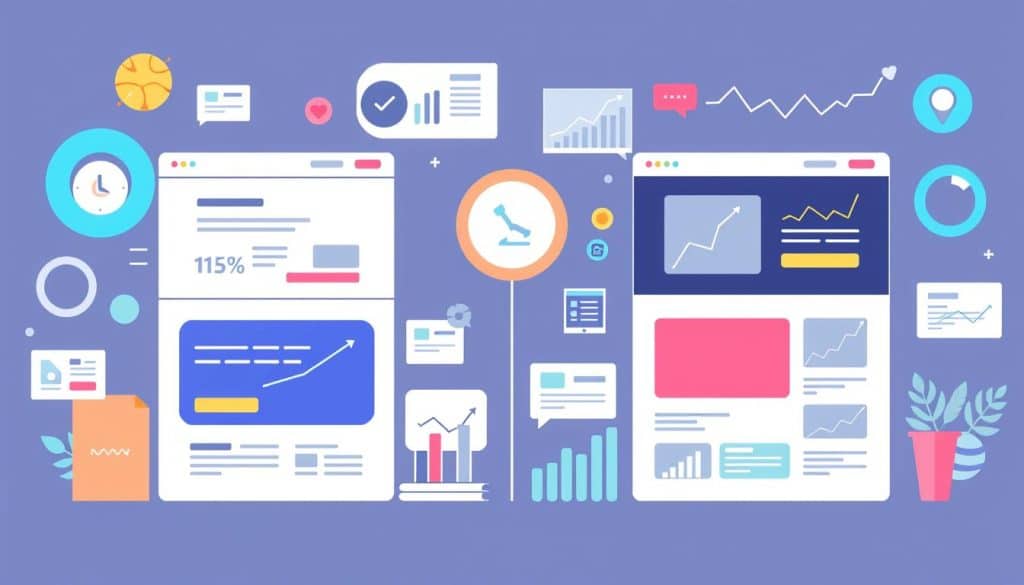Knowing who your target customers are is key for any business wanting to grow and last. It’s the base for good marketing and crucial for making products that people want. By finding out who your customers are, businesses can make things that really fit what customers need. This leads to more people getting involved and being happier with what they get.
This guide will explain why it’s important to know your target customers. It will show how this helps businesses do better in understanding what their customers want.
Key Takeaways
- Identifying your target customers is essential for effective marketing strategies.
- Customer identification strategies help tailor products and communication.
- Understanding customers enhances engagement and satisfaction.
- The foundation of business success lies in knowing your ideal audience.
- Effective targeting can significantly improve overall customer experience.
Understanding the Importance of Target Customers
Knowing who your customers are is key to a successful business plan. It helps create products that meet their needs and likes. Companies find that really understanding their market makes customers happier and more loyal.
Audience analysis is crucial. It makes sure marketing hits the mark, boosting its impact.
Why Knowing Your Audience Matters
Getting to know your audience boosts your product’s chance of success. By deeply understanding their likes, spending habits, and what bothers them, businesses can make products that really speak to them.
Impact on Marketing Strategies
Knowing your target customers changes how you market. Messages become more appealing when they’re made just for them. This leads to stronger connections and more sales.
| Aspect | Traditional Approach | Audience-Driven Approach |
|---|---|---|
| Product Development | Assumption-based | Data-driven, aligning with customer needs |
| Marketing Messages | Generic messaging | Personalised messaging |
| Customer Engagement | One-way communication | Interactive dialogues with customers |
| Customer Loyalty | Low retention rates | High retention rates through tailored experiences |
Defining Your Ideal Customer Persona
Knowing who your ideal customer is key to good branding. This person has many traits that help you focus your marketing.
Elements of a Customer Persona
A good customer persona has several important parts:
- Demographics: Age, gender, income, and location help paint a clear picture of your ideal customer.
- Behaviour Patterns: Seeing how customers use products or services shows what they like.
- Motivations: Knowing what drives customers to buy gives deeper insight into their choices.
- Pain Points: Knowing the problems your customers face helps you offer solutions they’ll find useful.
Creating a Profile that Reflects Your Goals
To make a strong customer persona, match your goals with what you learn. This approach helps in making branding strategies that really connect with customers. Keeping your customer personas up to date helps you stay relevant and boosts sales.
| Element | Description |
|---|---|
| Demographics | Basic information about your ideal customer’s age, gender, income, and location. |
| Behaviour Patterns | Insights into how customers interact with products and services. |
| Motivations | Factors that influence buying decisions and priorities of customers. |
| Pain Points | Specific challenges or problems that the target audience encounters. |
Identifying Your Target Customers
Knowing who your ideal customers are is key to making your marketing work. You need to look at both their demographics and psychographics. These give you insights into what they like and how they behave.
Key Attributes to Consider
When finding your target customers, think about these things:
- Age
- Gender
- Income level
- Education
- Occupation
- Interests
- Values
- Lifestyle
Demographics vs Psychographics
Demographics give you numbers about your audience, like their age and what they earn. This helps you focus your marketing. Psychographics go deeper, looking at what they care about and what they like to do. Using both helps you make marketing messages that really speak to your customers.
| Attribute Type | Examples | Purpose |
|---|---|---|
| Demographics | Age, Gender, Income Level | Segmentation and targeting based on measurable factors |
| Psychographics | Interests, Values, Lifestyle | Understanding customer motivation and preferences |
Researching Your Market

Understanding the market is key for businesses to make their products fit what customers want. There are many ways to do market research. By using both numbers and stories, companies can learn what people like and do.
Methods for Effective Market Research
Using different market research methods helps companies learn a lot. Some good ways include:
- Interviews: One-on-one chats that go deep into what customers think.
- Focus Groups: Group talks that show what people think about products or services together.
- Observational Studies: Watching how people use products in real life.
Utilising Surveys and Questionnaires
Surveys and questionnaires are strong tools for market research. They can get both numbers and stories from customers. They make it easy for many people to join in, giving a wide view of what customers think. Here’s a simple comparison of key aspects of effective surveys:
| Aspect | Description | Benefit |
|---|---|---|
| Format | Structured questions, both open and closed | Facilitates clear and concise responses |
| Target Audience | Specific demographic or psychographic segments | Ensures relevant data collection |
| Distribution Method | Email, social media, or in-person | Increased response rates and reach |
| Analysis | Statistical tools for quantitative and thematic analysis for qualitative | Rich insights into customer needs |
Leveraging Social Media Insights
Social media platforms are great for understanding what customers like. By using social media analytics, companies can see how people interact and what they prefer. This helps them make their marketing better.
These platforms give real-time data. This lets businesses see how engaged their audience is and spot trends. This is key to knowing what their target group likes.
Identifying Trends and Preferences
It’s important to keep up with what consumers are interested in. Social listening helps brands keep an eye on what people say about their products. By looking at comments and shares, companies can see what works well.
This info helps in making better products and marketing plans. It’s a big help in making smart choices.
Engaging with Your Audience Online
Talking to customers on social media builds loyalty and trust. It lets brands get quick feedback from their audience. This shows how people feel about their products.
Asking users to share their thoughts helps in understanding their needs. It also helps build a community. Sites like Twitter and Instagram make it easy to have real-time chats. This makes the customer experience much better.
Analysing Competitor Strategies
The business world is always changing. It’s vital for companies to deeply study their competitors. By looking at what market leaders do, businesses can find key insights. These insights help them grow and succeed. This part talks about why it’s important to understand what others in the market are doing.
Learning from Market Leaders
Market leaders often start trends that others copy. By watching their marketing and how they connect with customers, businesses can learn a lot. Some important lessons include:
- Innovation in Marketing: Looking at how competitors advertise can spark new ideas.
- Customer Engagement: Seeing how leaders talk to their customers shows how to keep them loyal.
- Product Diversification: Spotting what’s missing in competitors’ lines can show where to grow or stand out.
Identifying Gaps and Opportunities
Doing market research is key to finding chances to grow in a tough market. By finding where competitors are weak, businesses can make products that customers really want. Here are some ways to spot and use these gaps:
- Do a SWOT analysis (Strengths, Weaknesses, Opportunities, Threats) to see where competitors are lacking.
- Use customer feedback to find what’s not working with rival products or services.
- Put more effort into parts of the market that competitors ignore.
Segmenting Your Audience for Better Targeting
Getting your marketing right means reaching the right people. By using different market segmentation strategies, businesses can make their marketing more effective. This way, they can send messages that really speak to specific groups of people.
Types of Market Segmentation
There are several ways to segment the market:
- Demographic Segmentation: This method splits the market by age, gender, income, and education.
- Geographic Segmentation: It looks at where people live, helping businesses target by region, city, or country.
- Psychographic Segmentation: This focuses on what people value and believe in, giving deeper insights into their buying habits.
- Behavioural Segmentation: It studies how people act, like what they buy and how loyal they are to brands.
Benefits of Segmentation
Segmenting your audience brings big benefits. Here’s what you can gain:
| Benefit | Description |
|---|---|
| Increased Relevance | Customised messages hit the mark better, meeting the unique needs and likes of different groups. |
| Improved Engagement | Targeted marketing connects more with customers, leading to higher engagement and stronger brand ties. |
| Enhanced ROI | Campaigns focused on clear segments bring in better returns by targeting well and using resources wisely. |
Utilising Customer Feedback and Reviews

Customer feedback is key to a business’s success. It helps understand what customers like and what needs work. By collecting reviews, businesses can learn a lot about what makes customers happy and what doesn’t.
They can then use this feedback to make their products and services better. This makes customers more likely to come back and recommend the business to others.
Gathering Honest Feedback
There are several ways to get honest feedback from customers:
- Requesting feedback after purchase through email or SMS.
- Using surveys on receipt or follow-up emails.
- Monitoring social media for real-time opinions.
- Creating a special section on the website for testimonials.
Incorporating Insights into Your Strategy
Using feedback to shape your strategy is crucial. Here’s how to do it:
- Analyse feedback to spot trends and common issues.
- Use insights to improve products, making them more in line with what customers want.
- Change marketing messages based on what customers say.
- Make sure customer feedback directly affects business decisions.
By actively seeking out reviews and listening to what customers say, businesses can build loyalty and boost satisfaction. This leads to ongoing success and growth.
Creating Value-Driven Content
In the digital marketing world, making content that adds value is key to keeping your audience interested. Content that teaches, entertains, or solves problems grabs users’ attention. It also fits well with strategies that lead to long-term success. By making content that meets specific needs, brands can draw in more people.
How Content Can Attract Your Target Audience
Creating top-notch, relevant content is crucial to grab your audience’s attention. Know what your audience needs and likes to make content like blogs, videos, and social media posts they’ll enjoy. Your content should aim to inform and engage. It’s important for brands to have a consistent voice that speaks to their customers.
Tailoring Content to Meet Customer Needs
Personalisation is a big part of successful content marketing. By making content that matches your audience’s interests, you’re more likely to get them involved. Use methods like segmenting your audience and looking at feedback to shape your content. Doing this makes sure your content not only gets noticed but also builds loyalty and encourages more interaction.
Using Analytics Tools for Insights
Analytics tools help businesses understand customer behaviour deeply. They show what customers like and do. This knowledge lets companies make better marketing plans and improve their performance.
Understanding Customer Behaviour Through Data
For better marketing, it’s key to know what customers do with data analysis. Tools for behaviour analysis show how customers use products and services. This helps companies make their offerings more appealing to their audience.
Top Tools for Analytics
Many analytics platforms are great for giving businesses useful data and insights. They help track how customers interact with the business and make smart decisions. Here are some top analytics tools:
| Tool | Key Features | Best For |
|---|---|---|
| Google Analytics | Comprehensive website traffic analysis, user behaviour tracking, conversion tracking | Understanding website visitors and improving online marketing |
| HubSpot | In-depth marketing analytics, CRM integration, lead tracking | Integrating marketing and sales data for customer relationship management |
| Mixpanel | User-centric analytics, event tracking, funnel analysis | Tracking user interactions in web and mobile applications |
| Kissmetrics | Customer journey mapping, cohort analysis, segmentation | Understanding customer retention and engagement |
The Role of Email Marketing in Targeting Customers
Email marketing is key to engaging with potential customers and nurturing relationships. Having a targeted email list is crucial for effective email marketing. It lets businesses directly reach out to people who are interested. A well-made email list improves communication and boosts marketing success.
Building a Targeted Email List
Building a targeted email list means finding the right audience and making sure they want to hear from you. Here are some ways to get contacts:
- Offering discounts or special content for signing up.
- Using social media to promote sign-ups.
- Putting sign-up forms on your website.
Crafting Effective Email Campaigns
After making a targeted email list, focus on creating campaigns that grab attention and convert. Important parts of good email marketing include:
- Personalisation: Making content fit what each person likes can really boost engagement.
- Segmentation: Grouping your list helps send messages that hit the mark with different groups.
- Clear Calls to Action: Every email should have clear, strong calls to action to get people to act.
Using these strategies can turn emails into powerful tools. They help promote products and build trust and loyalty with customers.
Testing and Optimising Your Strategies

In today’s fast-changing marketing world, it’s crucial to keep improving your methods. Testing your marketing helps find what works and what doesn’t with your audience. A/B testing is key in this, letting you see which campaign version does better.
The Importance of A/B Testing
A/B testing splits your audience to test different versions of one thing, like email subject lines or ads. It shows what your customers like, helping to boost sales. Using A/B testing helps you make your marketing better by seeing what works.
Measuring Success and Making Adjustments
Key performance indicators (KPIs) set the standard for success in marketing tests. By looking at things like how many people click or buy, you learn what works. This helps you make changes to keep your marketing in line with what your audience wants and market trends.
| Metric | A/B Test Version A | A/B Test Version B |
|---|---|---|
| Click-Through Rate (%) | 15 | 22 |
| Conversion Rate (%) | 5 | 8 |
| Customer Engagement Score | 300 | 450 |
Building Long-Term Relationships with Customers
It’s key to build lasting relationships with customers for business growth. Using good loyalty strategies keeps customers and turns them into brand fans. By improving how you manage customer relationships, you learn what they like. This lets you offer them more personal experiences.
Strategies for Customer Loyalty
Good loyalty strategies help keep customers coming back. Here are some ways to do it:
- Setting up loyalty programmes that give rewards for buying again
- Offering special deals that match what customers like
- Using personal messages to keep customers interested
- Listening to what customers say to make things better
The Importance of Customer Support
Customer service is very important. Great support makes customers happy and keeps them around. Making customers feel important and supported makes them like their experience more. Here’s what makes good customer support:
- Answering quickly and helping with problems
- Having many ways to get help, like chat, email, and phone
- Training staff to be kind and consistent
- Using what customers say to make things better
Utilising Networking and Referrals
Networking is key for business growth and getting new customers. It helps build strong connections that can lead to valuable referrals. These referrals can greatly increase your customer base and make your brand more visible. By actively engaging, businesses can find new opportunities through their relationships.
Building a Network for Business Growth
To create a strong network, you need a plan and regular effort. Here are some important steps to grow your business network:
- Attend industry events and workshops to meet professionals with similar interests.
- Use online platforms like LinkedIn to grow your relationships.
- Join local business groups or associations to build community connections.
A strong network can bring in steady referrals, giving you a steady flow of new customers. The trust and mutual benefits in networking encourage people to recommend your services to others.
The Power of Word-of-Mouth Marketing
Word-of-mouth is vital in today’s marketing. Happy customers often tell others about their good experiences, creating interest in your brand. To use this power, try these methods:
- Ask satisfied clients to leave reviews and testimonials.
- Offer rewards for referrals to encourage customers to share.
- Keep providing top-notch customer service for positive interactions.
Good word-of-mouth strategies can turn customer happiness into a marketing tool, bringing in new customers. When combined with networking, your business can really stand out in the market.
Staying Adaptable to Market Changes
In today’s fast-changing market, being flexible is key to success. Companies need to adapt to stay ahead. Keeping an eye on trends helps them see what customers want and how the industry is moving.
This knowledge lets businesses make smart moves to grow. They can quickly adjust their plans to meet new challenges.
Monitoring Trends and Adapting Strategies
It’s important to watch the market closely. Companies can use tools, customer feedback, and look at their rivals to stay informed. This helps them make smart changes to keep up with customers.
By always checking their approach, businesses can improve their products and position in the market. This shows their ability to adapt.
Continuous Learning and Growth
Learning never stops in a successful business. Encouraging staff to grow professionally keeps the team sharp. This helps them keep up with new trends and make strong plans for growth.
By combining learning with flexibility, companies can not just survive but excel in a tough market.
Practical Steps to Identify Your Target Customers
Identifying your target customers needs a strategic plan. Start with thorough market research to learn about what they like and do. Surveys and focus groups are great ways to get direct feedback from potential buyers.
Then, create detailed customer personas that show who your ideal clients are. Look at their demographics, what they think and buy, to make your marketing more focused. This way, you can make strategies that really speak to your audience.
Use analytics tools to keep track of how customers interact with you. This data helps you make your approach better, keeping customers happy and loyal. Remember, listening to customer feedback is key. It helps you understand what the market needs, giving you more insights. With these steps, businesses can hit the mark and succeed.
















